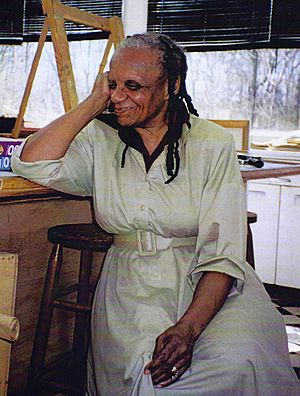Helen LaFrance facts for kids
Quick facts for kids
Helen LaFrance
|
|
|---|---|
 |
|
| Born | November 2, 1919 |
| Died | November 20, 2020 (aged 101) Mayfield, Graves County, Kentucky
|
| Movement | outsider art, memory painting Black art women artists |
Helen LaFrance (November 2, 1919 – November 20, 2020) was a self-taught Black American artist born in Graves County, Kentucky, the second of four daughters to James Franklin Orr and Lillie May Ligon Orr. Though the terms are confining, Helen was often described as both an outsider artist due to her lack of formal training and existence outside the cultural mainstream and as a memory painter, best known for her captures of the disappearing lifestyle of the rural South. She also painted powerful and intensely spiritual visionary interpretations of the Bible, in a style that differed radically from her memory paintings. Sharing traits in common with memory painters Horace Pippin (1888-1946) and Grandma Moses (1860-1961), LaFrance has been referred to as "the Black Grandma Moses."
Biography
LaFrance grew up in a nurturing household under Jim Crow laws, which between 1876 and 1965 prescribed segregation and disadvantaged social, economic and educational conditions for African Americans in the United States. Her father owned and farmed his land, growing tobacco, corn, black-eyed peas, beans, peanuts and sorghum, in a time when sharecropping was customary. Her parents bought school books to teach her at home and, after her chores were completed, she drew and carved in her spare time. Her artistic bent was encouraged from childhood, and she always followed her mother's wisdom to "paint what you know." She went to school in fifth grade, but later left to work on the farm. When her mother died, she left home to take various jobs in a hospital, caring for children, cooking, working in the tobacco barns and a ceramic factory where she decorated brand-name whiskey bottles. In her 40s, she made enough money to buy art supplies at the grocery store and in 1986 she began painting full-time.
Media
Not limited to two-dimensional media, LaFrance was an exceptional quilt maker and wood carver of animal sculptures and articulated dolls with handmade textile clothing. But it is her memory paintings that most strongly suggest a common experience. "Simply described, memory painting is a visual history of reminiscences coming from a particular frame of reference." Her sense of time and place resonate with the emotions and memories of the viewer, pulling them in. With oil on canvas, LaFrance shared the traditions of family and church and the values she grew up with, and recollections of coon hunts, fishing, planting and picking cotton and tobacco, growing flowers and using their petals for paint, the general merchandise store, barn dances, the circus, fish fries, family reunions, and church picnics where the community gathered together. She witnessed the Depression, the stock market crash, the war in Vietnam, and the passing of the Civil Rights Act of 1964 and the Voting Rights Act of 1965. It was that blend of personal experiences and expressive artistry that made Helen LaFrance a unique and an important American artist.
Notable features
LaFrance's work is represented in many notable public and private collections in this country and in Europe, including Oprah Winfrey, Gayle King, Bryant Gumbel, Beth Rudin DeWoody, and contemporary artist Red Grooms. Her work has been shown at county fairs, at the Mayfield, Kentucky bank and public library, Murray State University, the Kentucky Museum (Bowling Green), the National Black Fine Arts Show (New York City), and Color, an art show sponsored by Oprah Winfrey in Chicago. Her depiction of workers rolling cut tobacco is included in the Van Nelle collection of tobacco art in Amsterdam, the Netherlands, purchased on a visit to the Kentucky tobacco barn where she worked. The Owensboro Museum of Fine Art holds examples of her work in its collection and featured her in a cataloged show in 1991 called "Kentucky Spirit, the Naive Tradition." The Saint Louis Art Museum and The Speed Art Museum include her work in their permanent collections. The Kentucky Folk Art Center in Morehead also owns her work and has included her in its exhibitions. The subject of a Kentucky Educational Television (KET) program and other documentaries, she received the prestigious Folk Heritage Award for 2011, one of the Governor's Awards in the Arts presented by the Kentucky Arts Council. She is featured in a chapter of Kathy Moses' reference book, Outsider Art of the South. Her life and her work were documented in the award-winning screenplay by Marilyn Jaye Lewis, Tell My Bones: The Helen LaFrance Story and in the 2019 award-winning documentary "Helen LaFrance: Memories."
In later years, LaFrance resided in a Kentucky nursing home and said of her days, "When I'm not eating or sleeping, I'm painting." She celebrated her 100th birthday in 2019 among family and friends, many who traveled from as far as Memphis and Nashville, Tennessee to attend church, watch a 2019 award-winning documentary on her life and her art, and visit with her. LaFrance died in her sleep at the age of 101 in November 2020 in Mayfield, Kentucky.

